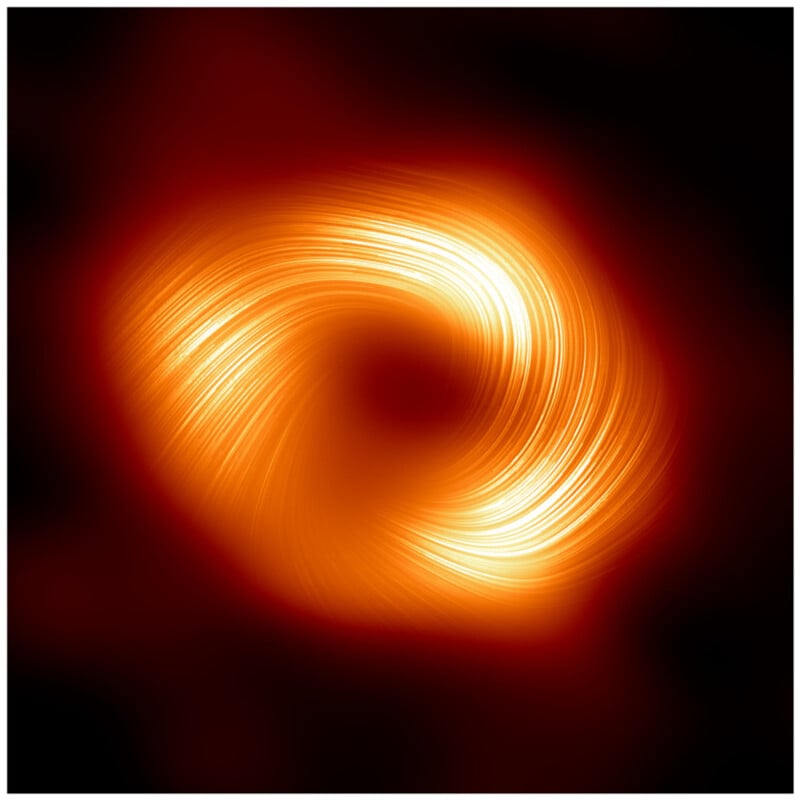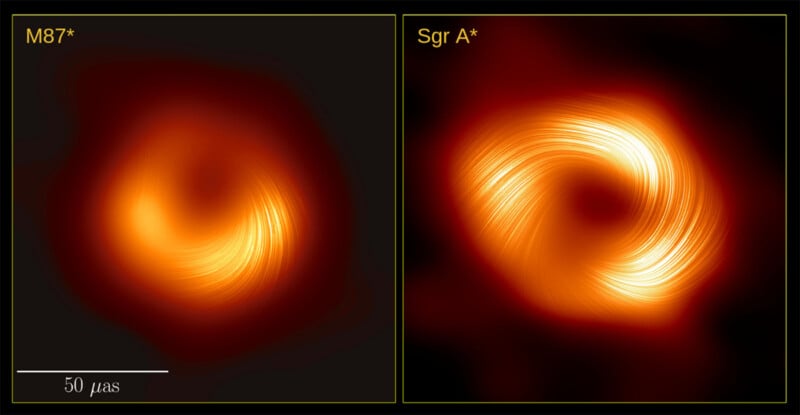Black Hole at the Center of the Milky Way Has Beautiful Magnetic Spirals

Astronomers using the groundbreaking Event Horizon Telescope (EHT) have captured the first view of the magnetic fields surrounding the supermassive black hole at the center of the Milky Way galaxy, Sagittarius A* (Sgr A*). The novel new image was captured using polarized light.
The historic new observation of Sgr A*’s magnetic fields looks a lot like the magnetic fields around Messier 87’s central supermassive black hole, M87*, imaged in 2021, lending credence to the idea that all black holes may feature similar magnetic fields.
While this idea may initially sound somewhat mundane, it is anything but. The result is surprising because Sgr A*’s mass is about 4.3 million times that of the Sun, while M87*’s is about 6.5 billion times that of the Sun. Despite the significant difference in mass between the two supermassive black holes, the fact that their magnetic fields behave similarly and are both well-organized is an incredible discovery.
![]()
“The fact that the magnetic field structure of M87* is so similar to that of Sgr A* is significant because it suggests that the physical processes that govern how a black hole feeds and launches a jet might be universal among supermassive black holes, despite differences in mass, size, and surrounding environment,” exclaims Mariafelicia De Laurentis, EHT Deputy Project Scientist and professor at the University of Naples Federico II, Italy. “This result allows us to refine our theoretical models and simulations, improving our understanding of how matter is influenced near the event horizon of a black hole.”
While scientists have been unable to find a corresponding powerful outflow of energy, or jet, in Sgr A* like has been found in M87*, there is reason to believe it’s there, but just hidden or perhaps too faint to observe.
“This new image of the black hole at the center of our Milky Way, Sgr A*, tells us that near the black hole are strong, twisted, and ordered magnetic fields,” Sara Issaoun, research co-leader and NASA Hubble Fellowship Program Einstein Fellow at the Center for Astrophysics (CfI) at Harvard & Smithsonian explains to Space. “For a while, we’ve believed that magnetic fields play a key role in how black holes feed and eject matter in powerful jets.”
Issaoun notes how similar the polarization structure of Sgr A* looks to M87*, adding that this strong, ordered magnetic field may be vital to how black holes exist and interact with surrounding gas and matter.

Light is an oscillating electromagnetic wave. When light oscillates in a “preferred orientation,” as it sometimes does, it is polarized light. While polarized light is everywhere, human eyes can distinguish it from “normal” light.
Within the plasma surrounding supermassive black holes like Sgr A* and M87*, particles “whirling around” show a polarization pattern perpendicular to the black hole’s magnetic field. By imaging these patterns, scientists can learn new things about what’s going on inside the supermassive black hole — where light itself is lost to observation — and map the magnetic field lines.
“By imaging polarized light from hot glowing gas near black holes, we are directly inferring the structure and strength of the magnetic fields that thread the flow of gas and matter that the black hole feeds on and ejects,” explains Harvard Black Hole Initiative Fellow and project co-lead Angelo Ricarte. “Polarized light teaches us a lot more about the astrophysics, the properties of the gas, and mechanisms that take place as a black hole feeds.”
Although the EHT has imaged M87* in polarized light already, getting the new image of Sgr A* was significantly more challenging. Although Sgr A* is a much closer target — nearly 27,000 light-years away versus 53.5 million light-years — it is much less stable.
“Making a polarized image is like opening the book after you have only seen the cover. Because Sgr A* moves around while we try to take its picture, it was difficult to construct even the unpolarized image,” says EHT Project Scientist Geoffrey Bower from the Institute of Astronomy and Astrophysics, adding that the first image was an average of multiple images due to Sgr A*’s movement. “We were relieved that polarized imaging was even possible. Some models were far too scrambled and turbulent to construct a polarized image, but nature was not so cruel.”
The Event Horizon Telescope, comprised of telescopes worldwide, is scheduled to examine Sgr A* again next month. The latest research has been published in two papers: First Sagittarius A* Event Horizon Telescope Results. VII. Polarization of the Ring and First Sagittarius A* Event Horizon Telescope Results. VIII. Physical Interpretation of the Polarized Ring. At the time of publishing, these links aren’t active, but they should be operational soon.
Image credits: Event Horizon Telescope Collaboration